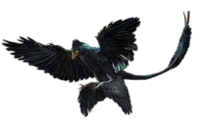
| Inkayacu | |
|---|---|

| |
| Scientific classification |
Inkayacu is an extinct genus of penguins that lived in what is now Peru during the Late Eocene, approximately 36 million years ago. A nearly complete skeleton was discovered in 2008, including fossilized feathers, the first known for penguins. A study of the melanosomes, pigment contained in organelles in the feathers, indicates that they were gray or reddish-brown in color. Its main difference from modern penguins is that its brown feathers had long, ellipsoidal melanosomes.
Although he is a penguin from 36 million years ago, Inkayacu closely resembles his current relatives. Inkayacu, along with other extinct penguins from Peru, is called the giant penguin due to its large size. Inkayacu was about 1.5 meters tall; the largest living penguin is the emperor penguin, which is about 1.2 meters tall.1
Inkayacu feather melanosomes are long and narrow, similar to those of most birds. Most modern penguins have melanosomes that are similar in length to those of the Inkayacu, but are broader. This means that while modern penguins have black or Isabella colored feathers, Inkayacu apparently had them gray or reddish brown. Despite the differences in the melanosomes, Inkayacu's feathers were similar to those of living penguins in all other respects.